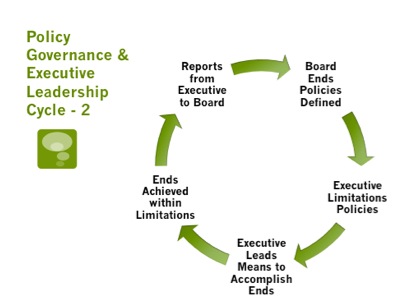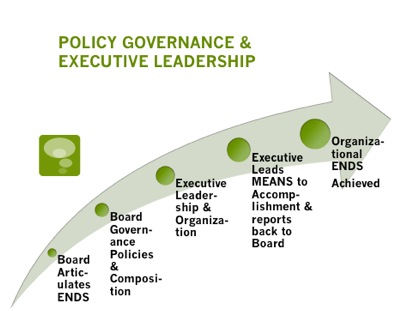Article XVII: The Board – Headmaster Relationship based on Governance Policies
There are several approaches to the government of an academy. The most important thing is to choose one that fits the academy and follows it carefully to maximize organizational performance. The following approach to the board – headmaster relationship is adapted from The Carver Institute Policy Governance Model.
“Policy Governance® is the world’s most complete theoretical foundation for the board’s governance role in business, nonprofit (NGO), and government organizations. Policy Governance is an integrated set of concepts and principles that describes the job of any governing board. It outlines the manner in which boards can be successful in their servant-leadership role, as well as in their all-important relationship with management. Unlike most solutions to the challenge of board leadership, its approach to the design of the governance role is neither structural nor piecemeal, but is comprehensively theory based. The model covers all legitimate intentions of corporate governance codes (including Sarbanes-Oxley), but in a far more comprehensive, theory-based manner.”
Summarizing this approach based on an actual board policy governance manual for an academy, the role of the board, on behalf of our Lord Jesus Christ and like minded Christian families in the Academy’s region is to assure that the Academy fulfills its intended ends and avoids unacceptable activities and conditions.
- The board will define in ends policies what is to be accomplished. It will define in executive limitations policies those activities and conditions it considers unacceptable. The board will delegate performance of these matters to a CEO, titled Headmaster.
- The board will carry out its job with discipline, emphasizing strategic rather than short-term issues, policy rather than single events, and group rather than individual decisions.
- The chairperson is charged to make decisions on issues of governance process and board-staff linkage within board policies.
- Conduct of board members will be consistent with their fiduciary responsibility and with the discipline adopted by the board.
- If board committees are necessary, they will assist in the board’s job only, never interfere in the direct link between the board and CEO, and never fragment the wholeness of the board’s job.
The board will link governance and management functions through a single chief executive officer, titled Headmaster by means of written management delegation policies such as those that follow.
- All board authority delegated to staff is delegated through the CEO so that all authority and accountability of staff as far as the board is concerned is considered to be authority and accountability of the CEO.
- The CEO is accountable to the board for achievement of provisions of the board’s ends policies and avoidance of provision of the board’s executive limitations policies.
- Monitoring data that discloses the degree of organizational performance upon Ends policies and Executive Limitations policies will be systematically gathered by the board and considered to be the only evaluation of CEO performance.
- Individual board members may have relationship with staff members but can never carry the instructive authority of the board, nor can they waive requirements set out by the board in relationship with staff.
The following two illustrations highlight the role of the board, the CEO and the linkage between each. This is not a hands off approach by the board unfettering a CEO for independent action, but rather a clear definition of roles for maximum organization achievement of clearly articulated ends without violating clearly articulated limitations on the means to accomplish such ends.

Upcoming Articles on The Headmaster as CEO Begin Soon:
When Chicken Little Cries, “The Sky if Falling!”
The Strategic Academy Assessment and Action Plan
Leadership Agility
And many more

